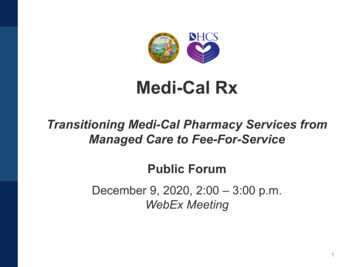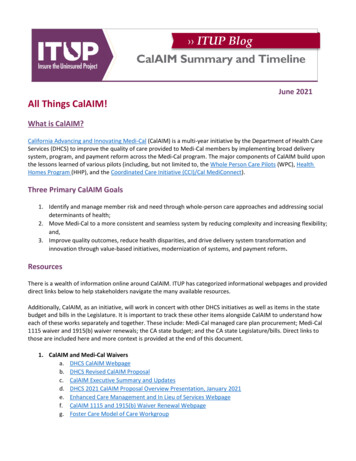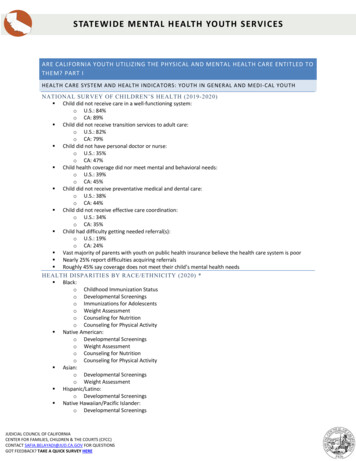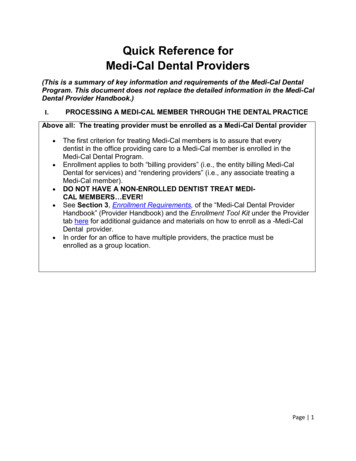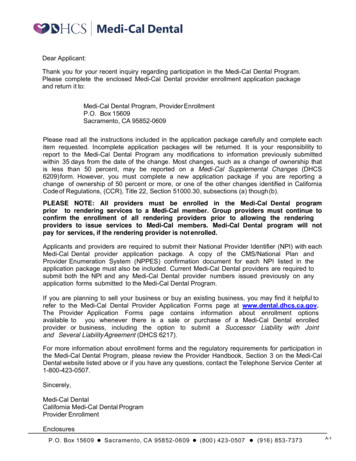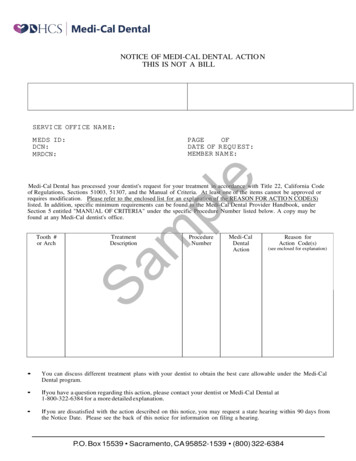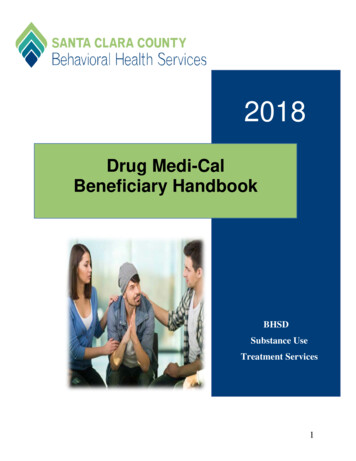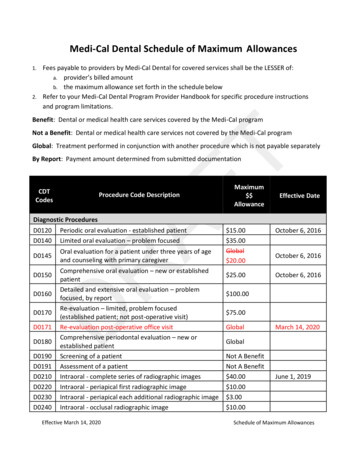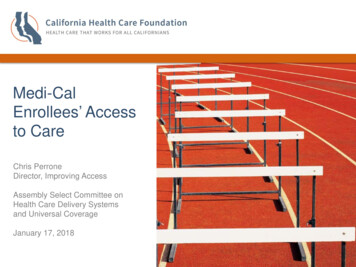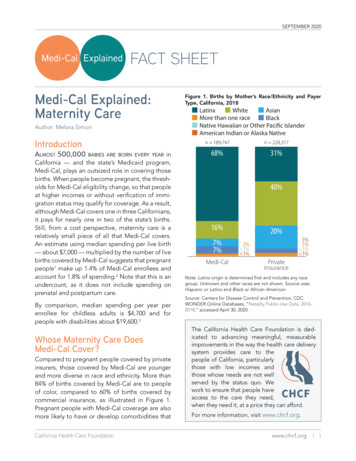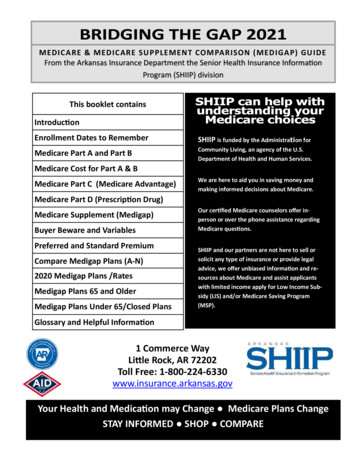
Transcription
MEDICARE & MEDICARE SUPPLEMENT COMPARISON (MEDIGAP) GUIDEFrom the Arkansas Insurance Department the Senior Health Insurance InformationProgram (SHIIP) divisionThis booklet containsIntroductionEnrollment Dates to RememberSHIIP is funded by the Administration forMedicare Part A and Part BCommunity Living, an agency of the U.S.Department of Health and Human Services.Medicare Cost for Part A & BMedicare Part C (Medicare Advantage)We are here to aid you in saving money andmaking informed decisions about Medicare.Medicare Part D (Prescription Drug)Medicare Supplement (Medigap)Buyer Beware and VariablesPreferred and Standard PremiumCompare Medigap Plans (A-N)2020 Medigap Plans /RatesMedigap Plans 65 and OlderMedigap Plans Under 65/Closed PlansOur certified Medicare counselors offer inperson or over the phone assistance regardingMedicare questions.SHIIP and our partners are not here to sell orsolicit any type of insurance or provide legaladvice, we offer unbiased information and resources about Medicare and assist applicantswith limited income apply for Low Income Subsidy (LIS) and/or Medicare Saving Program(MSP).Glossary and Helpful Information1 Commerce WayLittle Rock, AR 72202Toll Free: 1-800-224-6330www.insurance.arkansas.govYour Health and Medication may Change Medicare Plans ChangeSTAY INFORMED SHOP COMPARE
Table of ContentsTitle Page . 1Table of Contents . 2-3Introduction . 4Open Enrollment Dates . 5Getting Started with Medicare . 6How do I get Part A and Part B . 7Medicare Part A Cost . 8Medicare Part B Cost . 9Services Covered by Medicare . 10What is Medicare Part C . 11Cost for Medicare Advantage Part C Plans . 12Medicare Part D (Prescription Drug Plan) . 13When can I join, or switch a plan . 14When can I drop Part D Plan . 15Drug Coverage Rules . 17Drug Coverage Cost . 17What is Medicare Supplement (Medigap) . 18Types of Medicare Supplements . 19Not Medigap Plans . 20Difference between Medigap and MA Plans . 212
Table of ContentsBuyer Beware and Variables . 22Compare Medigap Plans and Benefits . 232020 Medigap Plans 65 and Over . 24-252020 Medigap Plans Under 65 . 262020 Medigap Plans Closed . 27Helpful Phone Numbers/Links and Websites . 28Glossary . 29-33[remainder of page purposefully left blank]Revised: 01/25/20213
INTRODUCTION: This guide summarizes Medicare and the benefits of MedicareSupplement Insurance (Medigap). Policies currently approved by the Arkansas InsuranceDepartment for sale. Inclusion of information in this guide regarding a policy does not, in anyway, constitute an endorsement of the policy or company by the Arkansas InsuranceDepartment.For quotes and exact premium cost contact a company or agent to purchase.Please note—BUYER BEWARE—page 22.BE ADVISED. Some new policies may have entered the marketplace since this publication was printedand will not be included. See the back cover of this publication, lower left corner for revision date.DO NOT BE ALARMED. If your Medicare Supplement Policy does not appear in this booklet. You maychoose to keep your policy as long as you pay the premium.Publication of this guide is for information purposes only. Please refer to the policy itself for the completeand actual terms of coverage since the policy constitutes the contract between the insurer and the insured and will ultimately be the basis of final determinations.SHOP WITH CAUTION. Do not just buy the cheapest policy without weighing other factors and determining the company’s financial stability and reputation for resolving complaints.AVOID HIGH PRESSURE SALES TACTICS. Take time and avoid being pushed into buying an insurance policy. Do not buy a policy under the pressure of limited enrollment periods or of ‘last chance toenroll.” Be wary of agents and sales material that imply a policy is connected with or endorsed by thegovernment. Medicare Supplement Insurance and Long-term Care insurance are not connected with orendorsed by the federal government.DON’T BE MISLED BY ADVERTISING. Do not buy a policy because celebrities endorse it on television,radio, newspaper, or other advertisements. Ask questions before buying a policy.BE CAREFUL HOW YOU PAY FOR POLICIES. Do not pay in cash. When purchasing Medicare Supplement Insurance, it is always best to pay by check, money order, or bank draft. Premium payments shouldalways be made payable to the insurance company, not the agent selling the policy. If you must pay incash, be sure to get a company-authorized receipt.KEEP YOUR POLICY IN A SAFE PLACE. Select a friend or relative in advance to handle your medicalaffairs in case of illness and let that person know where to locate your policy.KEEP RECORDS. Write down and keep the correct name, telephone number, and permanent address ofthe agent and the insurance company. Ask for a toll-free number in case you need to call long distance.Record important policy, company and agent information below and keep it in a safe place.4
MEDICARE SIGN UP PERIODSOCTOBER 15 - DECEMBER 7 (EACH YEAR)Medicare's Open Enrollment Period, during which you can freelyenroll in or switch plans,During this period you may enroll in a Medicare Part D (prescription drug) plan or, if you currently havea plan, you may change plans. In addition, during the seven-week period you can return to traditionalMedicare (Parts A and B) from a Medicare Advantage (Part C, managed care) plan, enroll in a Medicare Advantage plan, or change Advantage plans. Coverage elections will be effective January 1st.General Enrollment PeriodsJANUARY 1–MARCH 31 (EACH YEAR)You can sign up for Part A and/or Part B during the General Enrollment Period betweenJanuary 1 – March 31 each year if both of these apply: You didn't sign up when you were first eligibleYou aren’t eligible for a Special Enrollment Period (see below).You must pay premiums for Part A and/or Part B. Your coverage will start July 1. You may have to paya higher premium for late enrollment in Part A and/or a higher premium for late enrollment in Part B.Special circumstances (Special Enrollment Periods)Once your Initial Enrollment Period ends, you may have the chance to sign up for Medicare during aSpecial Enrollment Period (SEP). If you're covered under a group health plan based on currentemployment, you have a SEP to sign up for Part A and/or Part B anytime as long as: You or your spouse (or family member if you're disabled) is working.You're covered by a group health plan through the employer or union based on that work.You also have an 8-month SEP to sign up for Part A and/or Part B that starts at one of thesetimes (whichever happens first): The month after the employment endsThe month after group health plan insurance based on current employment endsUsually, you don't pay a late enrollment penalty if you sign up during a SEP.5
Getting Started with MedicareGetting Medicare is a major milestone. Here’s where you can get the information youneed, no matter where you are in your Medicare journey. Before you choose a pathbelow, check out these 5 important facts:1. Some people get Medicare automatically, and some have to sign up. You may haveto sign up if you’re 65 (or almost 65) and not getting Social Security.2. There are certain times of the year when you can sign up or change how you getyour coverage.3. If you sign up for Medicare Part B when you’re first eligible, you can avoid a penalty.4. You can choose how you get your Medicare coverage.5. You may be able to get help with your Medicare costsMedigap is supplemental Medicare insurance sold by private companies to help coveroriginal Medicare costs, such as deductibles, copayments, and coinsurance.Some people get Medicare Part A (Hospital Insurance) and Medicare Part B(Medical Insurance) automatically and other people have to sign up for it. In mostcases, it depends on whether you’re getting Social Security benefits.Many people need a Medicare supplement (Medigap) to help cover cost-sharing theyotherwise could not afford. For instance Plan F pays 100% of all out-of-pocket expenses but may cost more. A Medigap plan can help pay for: Medicare Part A coinsurancehospital costs after initial Medicare coverage is exhausted. After January 2020 Medigapplans will no longer cover Part B deductibles for new policies sold.In some cases, Medigap will also cover emergency medical fees when you’re travelingoutside the United States. A Medigap policy only pays out after both you and Medicarehave paid your share of costs for medical services.6
How do I get Part A & Part BWhen you first eligible for MedicareIf you're eligible for Medicare when you turn 65 you have a 7-month Initial Enrollment Period to signup for Part A and/or Part B.The 7-month period begins: 3 months before the month you turn 65Includes the month you turn 65Ends 3 months after the month you turn 65NoteIf you wait until the month you turn 65 (or the 3 months after you turn 65) to enroll, your Part Bcoverage will be delayed. This could cause a gap in your coverage.NoteIf you aren’t automatically enrolled, you can sign up for free Part A (if you’re eligible) any timeduring or after your Initial Enrollment Period starts. Your coverage start date will depend onwhen you sign up. If you have to buy Part A and/or Part B, you can only sign up during a validenrollment period.If you didn't get Part B when you're first eligible, your monthly premium may go up 10% for each12-month period you could've had Part B, but didn't sign up. In most cases, you'll have to pay thispenalty each time you pay your premiums, for as long as you have Part B. And, the penaltyincreases the longer you go without Part B coverage.Usually, you don't pay a late enrollment penalty if you meet certain conditions that allow you to signup for Part B during a Special Enrollment Period. Read more about different situations that mayaffect when you decide to get Part B.EXAMPLE:Your Initial Enrollment Period ended December 2016. You waited to sign up for Part B untilMarch 2019 during the General Enrollment Period. Your coverage starts July 1, 2019. Your PartB premium penalty is 20% of the standard premium, and you’ll have to pay this penalty for aslong as you have Part B. (Even though you weren't covered a total of 27 months, this includedonly 2 full 12-month periods.)7
How much does Part A cost?Part A CostsPremium-free Part AYou usually don't pay a monthly premium (periodic payment) for Medicare Part A (HospitalInsurance) coverage if you or your spouse paid Medicare taxes for a certain amount of timewhile working. This is sometimes called "premium-free Part A."Most people get premium-free Part A.You can get premium-free Part A at 65 if: You already get retirement benefits from Social Security or the Railroad Retirement Board. You're eligible to get Social Security or Railroad benefits but haven't filed for them yet. You or your spouse had Medicare-covered government employment.If you're under 65, you can get premium-free Part A if: You got Social Security or Railroad Retirement Board disability benefits for 24 months. You have End-Stage Renal Disease (ESRD) and meet certain requirements.Part A premiumsIf you don't qualify for premium-free Part A, you can buy Part A.If you buy Part A, you'll pay up to 471 each month. If you paid Medicare taxes for less than 30quarters, the standard Part A premium is 259.In most cases, if you choose to buy Part A, you must also:Have Medicare Part B (Medical Insurance) Pay monthly premiums for both Part A and Part B Contact Social Security for more information about the Part A premium.8
How much does Part B cost?Part B costsPart B PremiumYou pay a premium each month for Part B. Your Part B premium will be automatically deductedfrom your benefit payment if you get benefits from one of these: Social SecurityRailroad Retirement BoardOffice of Personnel ManagementIf you don’t get these benefit payments, you’ll get a bill.Most people will pay the standard premium amount. If your modified adjusted gross income isabove a certain amount, you may pay an Income Related Monthly Adjustment Amount (IRMAA).Medicare uses the modified adjusted gross income reported on your IRS tax return from 2 yearsago. This is the most recent tax return information provided to Social Security by the IRS.The standard Part B premium amount in 2021 is 148.50. Most people pay the standard Part Bpremium amount. If your modified adjusted gross income as reported on your IRS tax returnfrom 2 years ago is above a certain amount, you'll pay the standard premium amount and anIncome Related Monthly Adjustment Amount (IRMAA). IRMAA is an extra charge added to yourpremium.If your yearly income in 2018 (for what you pay in 2020) wasFile individual tax returnFile joint tax returnFile married & separatetax returnYou pay each month(in 2021) 88,000 or less 176,000 or less 88,000 or less 148.50above 88,000 up to 111,000above 111,000 up to 138,000above 138,000 up to 165,000above 165,000 and lessthan 500,000 500,000 or aboveabove 176,000 up to 222,000above 222,000 up to 276,000above 276,000 up to 330,000above 330,000 and lessthan 750,000 750,000 and aboveNot applicable 207.90Not applicable 297.00Not applicable 386.10above 88,000 and lessthan 412,000 412,000 and above 475.20 504.909
2020 Services Covered by MedicarePART A HOSPITAL INSURANCE COVERED SERVICESSERVICESBENEFITSMEDICARE PAYSYOU PAYHospitalizationSemiprivate room, generalnursing, misc. servicesFirst 60 days61st to 90th day91st and BeyondAll but 1,484All but 371 per dayAll but 742 per day 1,484 deductible 371 per day 742 per daySkilled Nursing Facility Care(SNF) after a 3 night hospitalstayFirst 20 days21st to 100th dayBeyond 100 days100% of approvedAll but 185.50 per dayNothingNothing if approved 185.50 per dayAll costsHome Health CareMedically necessary skilledcare, therapyPart-time care as longas you meet guidelines100% of approvedNothing if approvedHospice CareFor the terminally illAs long as doctorcertifies needAll but limited costs fordrugs & respite careLimited costs for drugs& respite careBloodBloodAll but first 3 pintsFirst 3 pintsPART B MEDICAL INSURANCE COVERED SERVICESSERVICESMedical ExpenseMEDICARE PAYSYOU PAY80% of approved amount(after 203 deductible)20% of approvedamount (after 203deductible)Clinical Laboratorydiagnostic tests100% of approvedNothing if approvedHome Health CareMedically necessary skilled care, home health aideservices, medical supplies etc. after a 3-dayinpatient hospital stay, Requires a prescription.100% of approvedNothing if approvedOutpatient Hospital TreatmentUnlimited if medically necessary80% of approved20% of approvedamount (after 203deductible)Durable Medical EquipmentPrescribed by a doctor for use in home80% of approved amount(after 203 deductible)20% of approvedamount (after 203deductible)80% of approved amount(after 203 deductible andafter the first 3 pints)20% of approvedamount (after 203deductible and afterpayment of the first 3pints)Physician services and medical supplies in and outof the hospital.Blood10
What is Medicare Part CMedicare Part C is known as Medicare Advantage. These are private plans run through Medicarethat, by law, must at least be "equivalent" to regular Part A and Part B coverage. But there's lots ofvariation among Part C plans.How does Medicare Advantage Plans work?Medicare Advantage Plans, sometimes called "Part C" or "MA Plans," are an “all in one” alternativeto Original Medicare. They are offered by private companies approved by Medicare. If you join aMedicare Advantage Plan, you still have Medicare. These "bundled" plans include Medicare Part A(Hospital Insurance) and Medicare Part B (Medical Insurance), and usually Medicare prescriptiondrug (Part D).Medicare pays a fixed amount for your care every month to the companies offering MedicareAdvantage Plans. These companies must follow rules set by Medicare. However, each MedicareAdvantage Plan can charge different out-of-pocket costs and have different rules for how you getservices (like whether you need a referral to see a specialist or if you have to go to only doctors,facilities, or suppliers that belong to the plan for non‑emergency or non-urgent care). These rulescan change each year.Find Medicare Advantage Plans offered in 2020 (page 24).What are the different types of Medicare Advantage Plans? Health Maintenance Organization (HMO) plan HMO Point-of-Service (HMOPOS) plan: This HMO plan may allow you to get some servicesout-of-network for a higher copayment or coinsurance. Medical Savings Account (MSA) plans. Preferred Provider Organization (PPO) plan. Private Fee-for-Service (PFFS) plan. Special Needs Plan (SNP).Covered services in Medicare Advantage PlansMedicare Advantage Plans cover all Medicare services. Some Medicare AdvantagePlans also offer extra coverage, like vision, hearing and dental coverage. Learnmore about what Medicare Advantage Plans cover.Medicare Advantage Plans cover almost all Medicare Part A and Part B benefits. Plans must coverall emergency and urgent care, and almost all medically necessary services Original Medicarecovers. However, if you’re in a Medicare Advantage Plan, Original Medicare will still cover the costfor hospice care, some new Medicare benefits, and some costs for clinical research studies.11
Costs for Part C - Medicare AdvantageWhat you pay in a Medicare Advantage PlanYour out-of-pocket costs in a Medicare Advantage Plan (Part C) depend on: Whether the plan charges a monthly premium. Many Medicare Advantage Plans have a 0premium. If you enroll in a plan that does charge a premium, you pay this in addition to thePart B premium. Whether the plan pays any of your monthly Medicare premiums. Some Medicare AdvantagePlans will help pay all or part of your Part B premium. This benefit is sometimes called a“Medicare Part B premium reduction.” Whether the plan has a yearly deductible or any additional deductibles for certain services. How much you pay for each visit or service (copayments or coinsurance). Medicare Advantage Plans can’t charge more than Original Medicare for certain services, likechemotherapy, dialysis, and skilled nursing facility care. The type of health care services you need and how often you get them. Whether you get services from a network provider or a provider that doesn’t contract with theplan. If you go to a doctor, other health care provider, facility, or supplier that doesn’t belongto the plan’s network for non-emergency or non-urgent care services, your plan may not coveryour services, or your costs could be higher. In most cases, this applies to Medicare Advantage Plans, Health Maintenance Organizations and Preferred Provider Organizations. Whether you go to a doctor or supplier who accepts assignment (if you’re in a Preferred Provider Organization or Private Fee-for-Service plan, or Medical Savings Account plan and yougo out of network). Whether the plan offers extra benefits (in addition to Original Medicare benefits) and if youneed to pay extra to get them. The plan’s yearly limit on your out of pocket costs for all Part A and Part B medical services.Once you reach this limit, you’ll pay nothing for Part A and Part B covered services. Whether you have Medicaid or get help from your state through a Medicare Savings Program.12
Medicare (Part D) Drug CoverageHow does Medicare drug coverage work?Medicare drug coverage helps pay for prescription drugs you need. Even if you don’t takeprescription drugs now, you should consider getting Medicare drug coverage. Medicare drugcoverage is optional and is offered to everyone with Medicare. If you decide not to get itwhen you’re first eligible, and you don’t have other creditable prescription drug coverage (likedrug coverage from an employer or union) or get Extra Help, you’ll likely pay a late enrollment penalty if you join a plan later. Generally, you’ll pay this penalty for as long as youhave Medicare drug coverage. To get Medicare drug coverage, you must join a Medicareapproved plan that offers drug coverage. Each plan can vary in cost and specific drugs covered. Visit Medicare.gov/plan-compare to find and compare plans in your area or contactyour AR SHIIP office 1-800-224-6330.There are 2 ways to get Medicare drug coverage:1Medicare drug plans. These plans add drug coverage to OriginalMedicare, some Medicare Cost Plans, some Private Fee-for-Service plans, and Medical Savings Account plans. You must2Medicare Advantage Plans or other Medicare health plans withdrug coverage. You get all of your Part A, Part B, and drug coverage, through these plans. Remember, you must have Part A andPart B to join a Medicare Advantage Plan, and not all of these[remainder of page purposefully left blank]13
When can I join, or switch a plan?You can join, switch, or drop a Medicare drug plan or aMedicare Advantage Plan with drug coverage during thesetimes: Initial Enrollment Period. When you first become eligible for Medicare, you can join a plan(see page 11). Open Enrollment Period. From October 15 – December 7 each year, you can join, switch,or drop a plan. Your coverage will begin on January 1 (as long as the plan gets yourrequest by December 7). Medicare Advantage Open Enrollment Period. From January 1 – March 31 each year, ifyou’re enrolled in a Medicare Advantage Plan, you can switch to a different MedicareAdvantage Plan or switch to Original Medicare (and join a separate Medicare drug plan)once during this time. See page 17 - 18 for more information.If you have to pay a premium for Part A and enroll in Part B for the first time during theGeneral Enrollment Period, you can also join a plan from April 1 – June 30. Your coveragewill begin on July 1.Special Enrollment PeriodsGenerally, you must stay enrolled in your plan for the entire year. But when certain eventshappen in your life, like if you move or lose other insurance coverage, you may qualify for aSpecial Enrollment Period. You may be able make changes to your plan mid-year if youqualify. Check with your plan for more information.How do I switch plans?You can switch to a new Medicare drug plan or Medicare Advantage Plan with drugcoverage simply by joining another plan during one of the times listed above. Your old drugcoverage will end when your new drug coverage begins. You should get a letter from yournew plan telling you when your coverage begins, so you don’t need to cancel your old plan.You can switch plans by calling 1-800-MEDICARE (1-800-633-4227). TTYusers can call 1-877-486-2048.14
When can I drop a plan?How do I drop my plan?If you want to drop your Medicare drug plan or Medicare Advantage Plan with drug coverageand don’t want to join a new plan, you can only do so during certain times (see page 12). Youcan disenroll by calling 1-800-MEDICARE (1-800-633-4227). TTY users can call1-877-486-2048. You can also send a letter to the plan to tell them you want to disenroll. If youdrop your plan and want to join another Medicare drug plan or Medicare health plan with drugcoverage later, you have to wait for an enrollment period. You may have to pay a late enrollmentpenalty if you don’t have creditable prescription drug coverage.Read the “Evidence of Coverage” and “Annual Notice ofChange” you get from your planYou will receive the plan information each year. The Evidence of Coverage gives you detailsabout what the plan covers, how much you pay, and more. The Annual Notice of Changeincludes any changes in coverage, costs, provider networks, service area, and more that will beeffective in January. If you don’t get these important documents in early fall, contact your plan.How much do I pay?Your drug costs will vary based on the plan you choose. Remember, plancoverage and costs can change each year. You may have to pay a premium, deductible, copayments, or coinsurance throughout the year. Learnmore about these costs on the next page.[remainder of page purposefully left blank]15
Drug Coverage RulesPlans may have coverage rules for certain drugs Prior authorization: You and/or your prescriber must contact your plan before you can fillcertain prescriptions. Your prescriber may need to show that the drug is medically necessary forthe plan to cover it. Plans may also use prior authorization when they cover a drug for onlycertain medical conditions it is approved for, but not others. When this occurs, plans will likelyhave alternative drugs on their list of covered drugs (formulary) for the other medical conditionsthe drug is approved to treat.Quantity limits: Limits on how much medicine you can get at a time.Step therapy: You may need to try one or more similar, lower-cost drugs before the plan willcover the prescribed drug.Prescription safety checks at the pharmacy (including opioid pain medicine): Before thepharmacy fills your prescriptions, your Medicare drug plan and pharmacy perform additionalsafety checks, like checking for drug interactions and incorrect dosages. These safety checksalso include checking for possible unsafe amounts of opioids, limiting the days supply of a firstprescription for opioids, and use of opioids at the same time as benzodiazepines (commonlyused for anxiety and sleep). Opioid pain medicine (like oxycodone and hydrocodone) can helpwith certain types of pain, but have risks and side effects (like addiction, overdose, and death).These can increase when you take opioids with certain other drugs, like benzodiazepines,anti-seizure medications, gabapentin, muscle relaxers, certain antidepressants, and drugs forsleeping problems. Check with your doctor or pharmacist if you have questions about risks orside effects.Drug Management Programs: Some Medicare drug plans and health plans with drug coveragehave a program in place to help you use these opioids and benzodiazepines safely. If you getopioids from multiple doctors or pharmacies, your plan will contact the doctors who prescribedthese drugs to make sure they’re medically necessary and you’re using them appropriately.If your plan decides your use of prescription opioids and benzodiazepines may not be safe, theplan will send you a letter in advance. This letter will tell you if the plan will limit coverage ofthese drugs for you, or if you’ll be required to get the prescriptions for these drugs only from onedoctor or pharmacy you select. You and your doctor have the right to appeal these limitations ifyou disagree with the plan’s decision. The letter will also tell you how to contact the plan if youhave questions or would like to appeal.The opioid safety reviews at the pharmacy and the Drug Management Programs generallydon’t apply if you have cancer, are getting palliative or end-of-life care, are in hospice, or live ina long-term care facility.If you or your prescriber believes that your plan should waive one of thesecoverage rules, you may be able to ask for an exception .16
Drug Coverage CostYour actual drug coverage costs will vary depending on: Your prescriptions and whether they’re on your plan’s list of covered drugs (a “formulary”)each plan has its own formulary. What “tier” the drug is in (Medicare health plans with drug coverage place drugs into differentlevels). Which drug benefit phase you’re in (like whether you’ve met your deductible, or if you’re inthe catastrophic coverage phase. Which pharmacy you use (whether it offers preferred or standard cost sharing, is out of network, or is mail order). Your out-of-pocket drug costs may be less at a preferred pharmacy because it has agreed with your plan to charge less.Whether you get Extra Help paying your drug coverage costs (see box below).You may be able to lower the cost of your drugs. Some ways include choosinggenerics over brand name or paying the non-insurance cost of a drug. Ask yourpharmacist they can tell you if there’s a less expensive option available. Check withyour doctor to make sure the generic option
Medigap is supplemental Medicare insurance sold by private companies to help cover original Medicare costs, such as deductibles, copayments, and coinsurance. Many people need a Medicare supplement (Medigap) to help cover cost-sharing they otherwise could not afford. For instance Plan F pays 100% of all out-of-pocket expens-es but may cost more.
